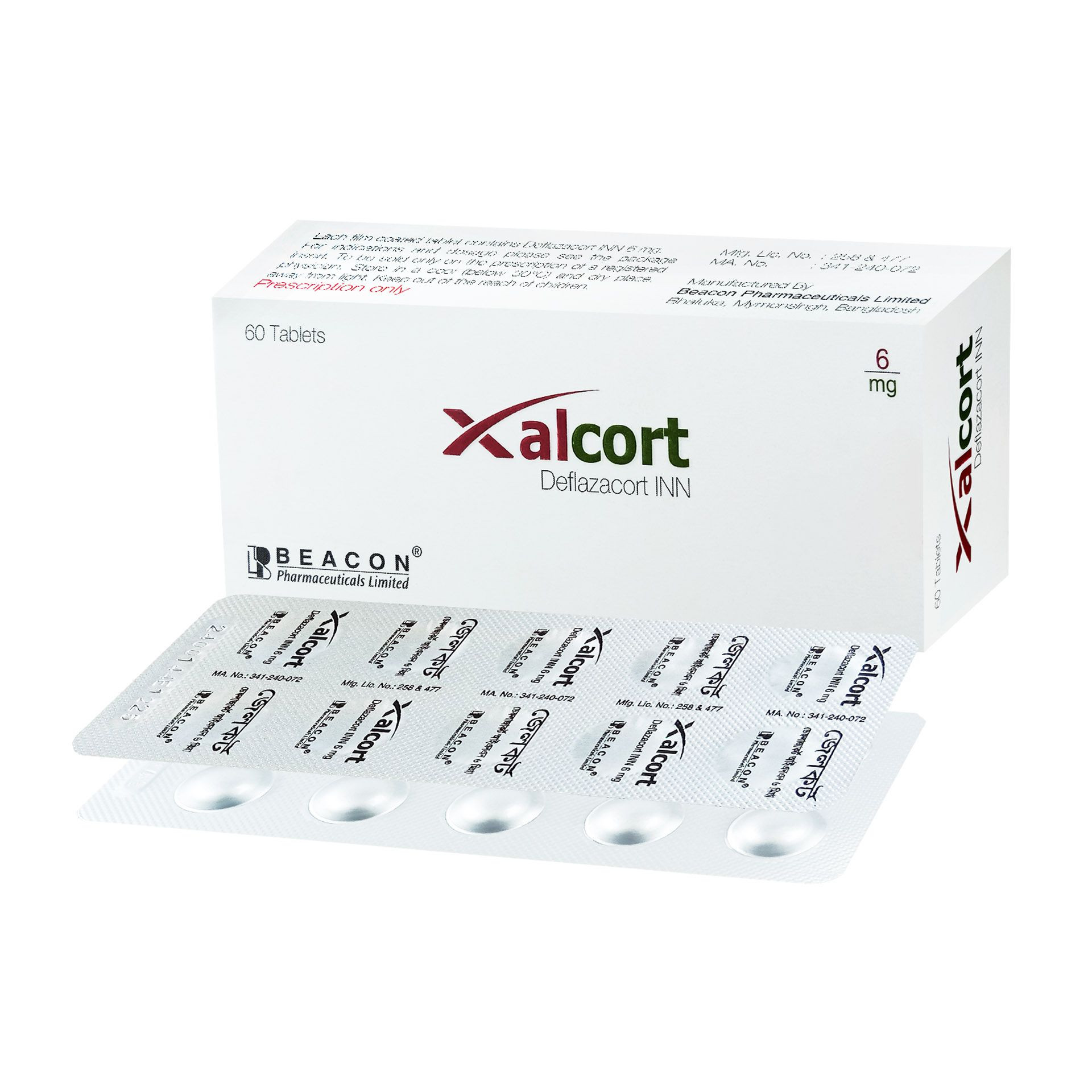Unit Price:
৳ 10.00
(6 x 10: ৳ 600.00)
Strip Price:
৳ 100.00
Also available as:
Indications
Xalcort is indicated in-
- Anaphylaxis, asthma, severe hypersensitivity reactions
- Rheumatoid arthritis, juvenile chronic arthritis, polymyalgia rheumatica
- Systemic lupus erythematosus, dermatomyositis, mixed connective tissue disease (other than systemic sclerosis), polyartritis nodosa, sarcoidosis
- Pemphigus, bullous pemphigoid, pyoderma gangrenosum
- Minimal change nephrotic syndrome, acute interstitial nephritis
- Rheumatic carditis
- Ulcerative colitis, Crohn's disease
- Uveitis, optic neuritis
- Autoimmune haemolytic anaemia, idiopathic thrombocytopenic purpura
- Acute and lymphatic leukaemia, malignant lymphoma, multiple myeloma
- Immune suppression in transplantation
Pharmacology
Deflazacort provides anti-inflammatory action by inhibiting Phospholipase A2 enzyme which is responsible for prostaglandin synthesis. Besides Deflazacort decreases the release of certain chemicals that are important in the immune system. By decreasing the release of these chemicals Deflazacort provides immunosuppressive action.
Dosage & Administration
Adults-
The following ranges provide general guidance:
- For acute disorders: Up to 120 mg/day Deflazacort may need to be given initially. Maintenance doses in most conditions are within the range of 3-18 mg/day.
- Rheumatoid arthritis: The maintenance dose is usually within the range of 3-18 mg/day. The smallest effective dose should be used and increased if necessary.
- Bronchial asthma: In the treatment of an acute attack, high doses of 48-72 mg/day may be needed depending on severity and gradually reduced once the attack has been controlled. For maintenance in chronic asthma, doses should be titrated to the lowest dose that controls symptoms.
- Other conditions: The dose of Deflazacort depends on clinical need titrated to the lowest effective dose for maintenance. Starting doses may be estimated on the basis of ratio of 5 mg prednisone or prednisolone to 6 mg.
The following ranges provide general guidance:
- Juvenile chronic arthritis: The usual maintenance dose is between 0.25-1.0 mg/kg/day.
- Nephrotic syndrome: Initial dose of usually 1.5 mg/kg/day followed by down titration according to clinical need.
- Bronchial asthma: On the basis of the potency ratio, the initial dose should be between 0.25-1.0 mg/kg on alternate days.
Interaction
Xalcort is metabolized in the liver. It is recommended to increase the maintenance dose of Xalcort if drugs which are liver enzyme inducers are co-administered, e.g. rifampicin, rifabutin, carbamazepine, phenobarbitone, phenytoin, primidone and aminoglutethimide. For drugs which inhibit liver enzymes, (e.g. ketoconazole) it may be possible to reduce the maintenance dose of Xalcort.
Contraindications
Hypersensitivity to or any of the ingredients. Patients receiving live virus immunization.
Side Effects
GI disturbances, musculoskeletal, endocrine, neuropsychiatric, ophthalmic, fluid and electrolyte disturbances; susceptible to infection, impaired healing, hypersensitivity, skin atrophy, striae, telangiectasia, acne, myocardial rupture following recent Ml, thromboembolism.
Pregnancy & Lactation
Pregnancy: Deflazacort does cross the placenta. However, when administered for prolonged periods or repeatedly during pregnancy, corticosteroids may increase the risk of intrauterine growth retardation. As with all drugs, corticosteroids should only be prescribed when the benefits to the mother and child outweigh the risks.
Nursing Mother: Corticosteroids are excreted in breast milk, although no data are available for Deflazacort. Doses of up to 50 mg daily of Deflazacort are unlikely to cause systemic effects in the infant. Infants of mothers taking higher doses than this may have a degree of adrenal suppression but the benefits of breastfeeding are likely to outweigh any theoretical risk.
Nursing Mother: Corticosteroids are excreted in breast milk, although no data are available for Deflazacort. Doses of up to 50 mg daily of Deflazacort are unlikely to cause systemic effects in the infant. Infants of mothers taking higher doses than this may have a degree of adrenal suppression but the benefits of breastfeeding are likely to outweigh any theoretical risk.
Precautions & Warnings
The following clinical conditions require special caution and frequent patient monitoring is necessary-
- Cardiac disease or congestive heart failure (except in the presence of active rheumatic carditis), hypertension, thromboembolic disorders. Glucocorticoids can cause salt and water retention and increased excretion of potassium. Dietary salt restriction and potassium supplementation may be necessary.
- Gastritis or oesophagitis, diverticulitis, ulcerative colitis if there is the probability of impending perforation, abscess or pyogenic infections, fresh intestinal anastomosis, active or latent peptic ulcer.
- Diabetes mellitus or family history, osteoporosis, myasthenia gravis, renal insufficiency.
- Emotional instability or psychotic tendency, epilepsy.
- Previous corticosteroid-induced myopathy.
- Liver failure.
- Hypothyroidism and cirrhosis, which may increase the glucocorticoid effect.
- Ocular herpes simplex because of possible corneal perforation.
Use in Special Populations
Hepatic Impairment: In patients with hepatic impairment, blood levels of may be increased. Therefore the dose of Xalcort should be carefully monitored and adjusted to the minimum effective dose.
Renal Impairment: In renally impaired patients, no special precautions other than those usually adopted in patients receiving glucocorticoid therapy are necessary.
Elderly: In elderly patients, no special precautions other than those usually adopted in patients receiving glucocorticoid therapy are necessary. The common adverse effects of systemic corticosteroids may be associated with more serious consequences in old age.
Renal Impairment: In renally impaired patients, no special precautions other than those usually adopted in patients receiving glucocorticoid therapy are necessary.
Elderly: In elderly patients, no special precautions other than those usually adopted in patients receiving glucocorticoid therapy are necessary. The common adverse effects of systemic corticosteroids may be associated with more serious consequences in old age.
Therapeutic Class
Glucocorticoids
Storage Conditions
Store in a cool (below 25°C) and dry place, protected from light & moisture. Keep out of the reach of children.


